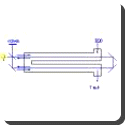 Fizeau’s fringes occur in interferometry. One of the most common methods used to test the flatness of a polished surface is by analysing the interference patterns formed when the surface is placed against another polished flat transparent surface. When two surfaces are fully in contact, a pattern of concentric dark and light circles is seen and these patterns (or fringes) are called Newton’s rings. However, when the surfaces are separated by a very thin wedgeshaped layer of air, straight, parallel, dark and light patterns are produced and these are called Fizeau’s fringes. These fringes are named in honour of French physicist Armand Hippolyte Louis Fizeau (1819-1896), who used the interference of light to measure the dilation of crystals.
Fizeau’s fringes occur in interferometry. One of the most common methods used to test the flatness of a polished surface is by analysing the interference patterns formed when the surface is placed against another polished flat transparent surface. When two surfaces are fully in contact, a pattern of concentric dark and light circles is seen and these patterns (or fringes) are called Newton’s rings. However, when the surfaces are separated by a very thin wedgeshaped layer of air, straight, parallel, dark and light patterns are produced and these are called Fizeau’s fringes. These fringes are named in honour of French physicist Armand Hippolyte Louis Fizeau (1819-1896), who used the interference of light to measure the dilation of crystals.
Check Also
Charan Singh Death Anniversary: 29 May – 5th Prime Minister of India
Chaudhary Charan Singh was the leader of Lok Dal and former prime minister of India …
 Kids Portal For Parents India Kids Network
Kids Portal For Parents India Kids Network






